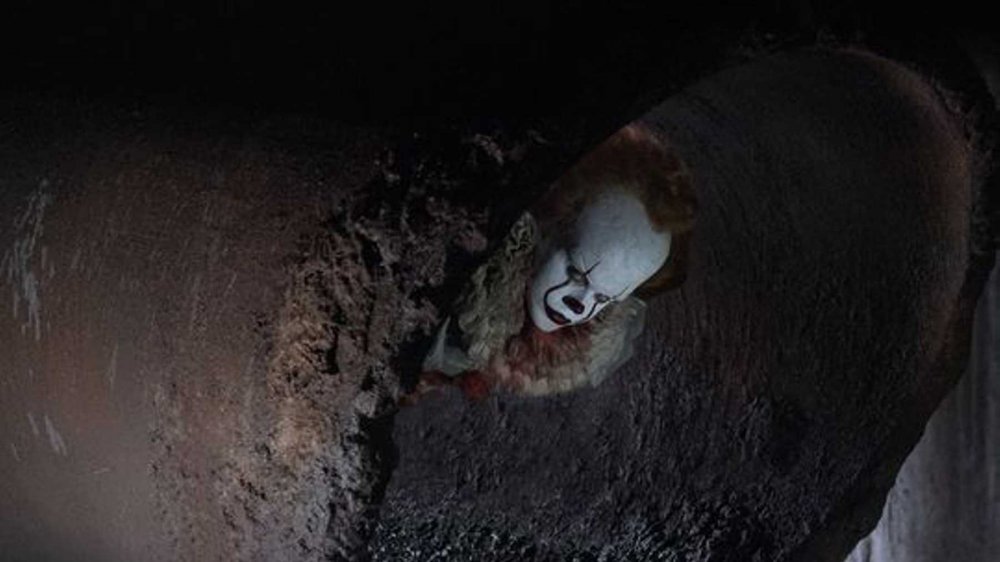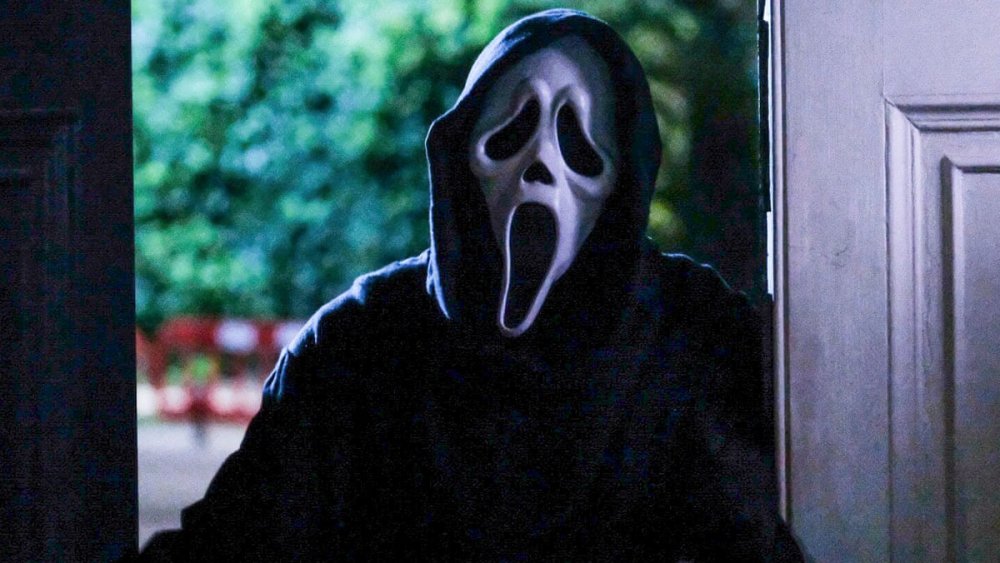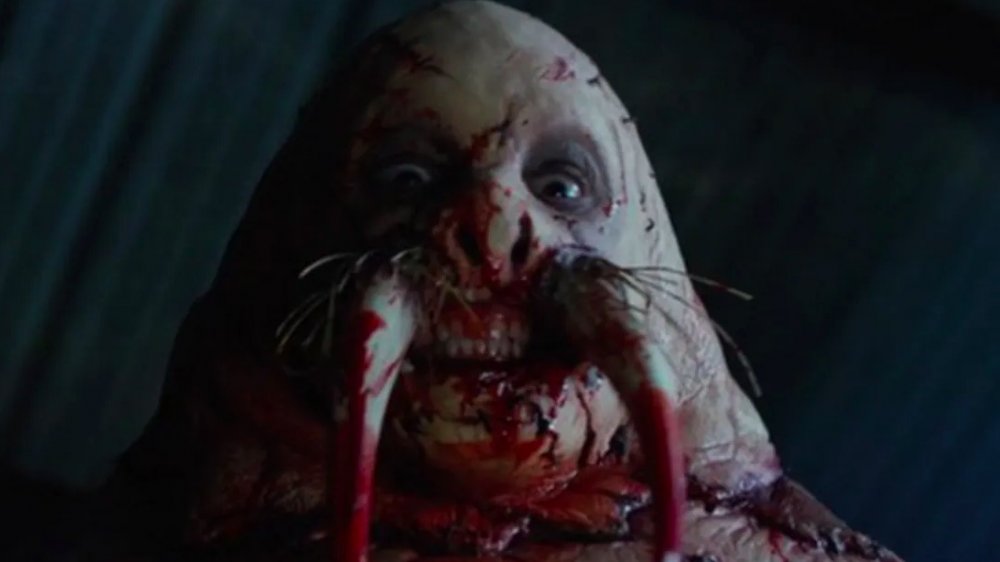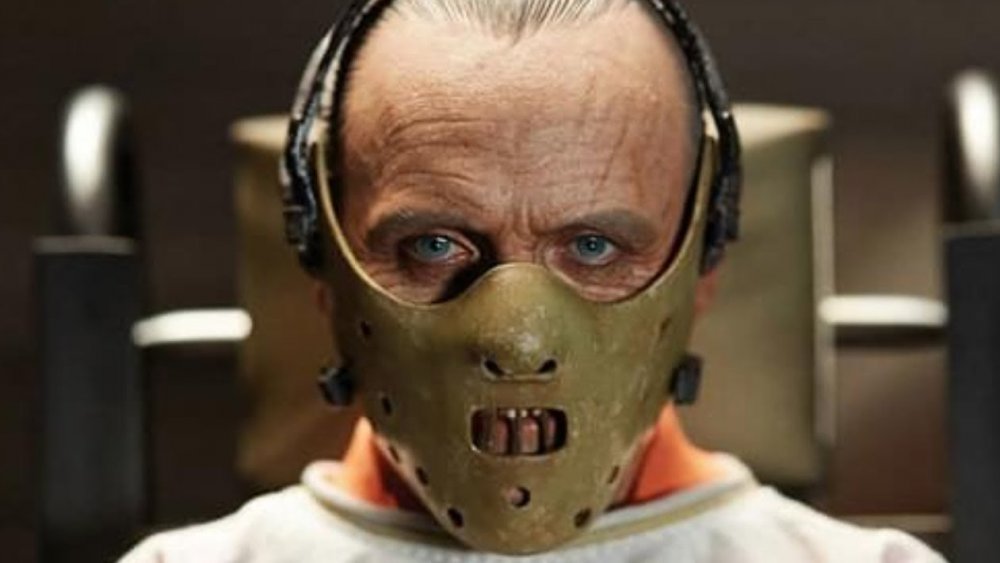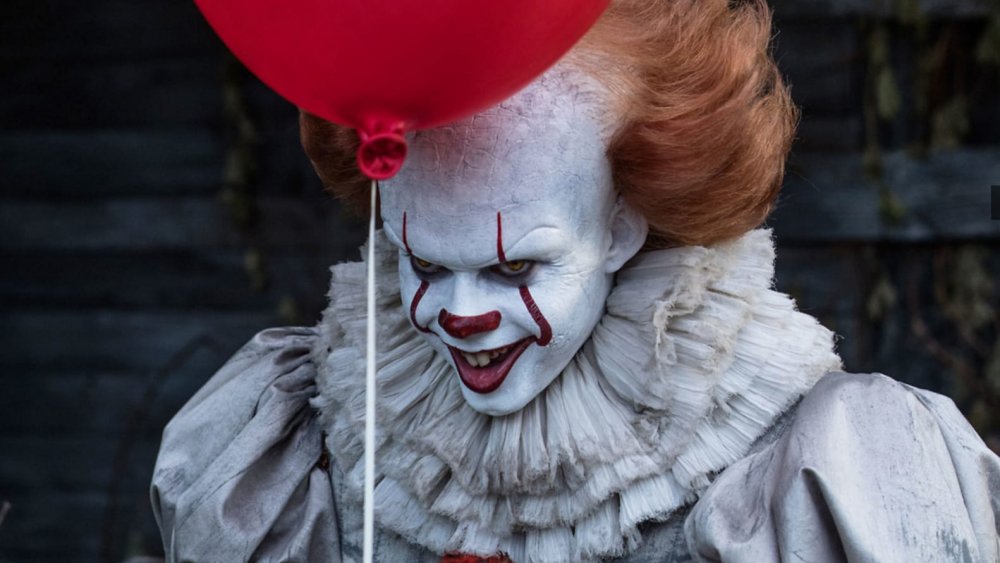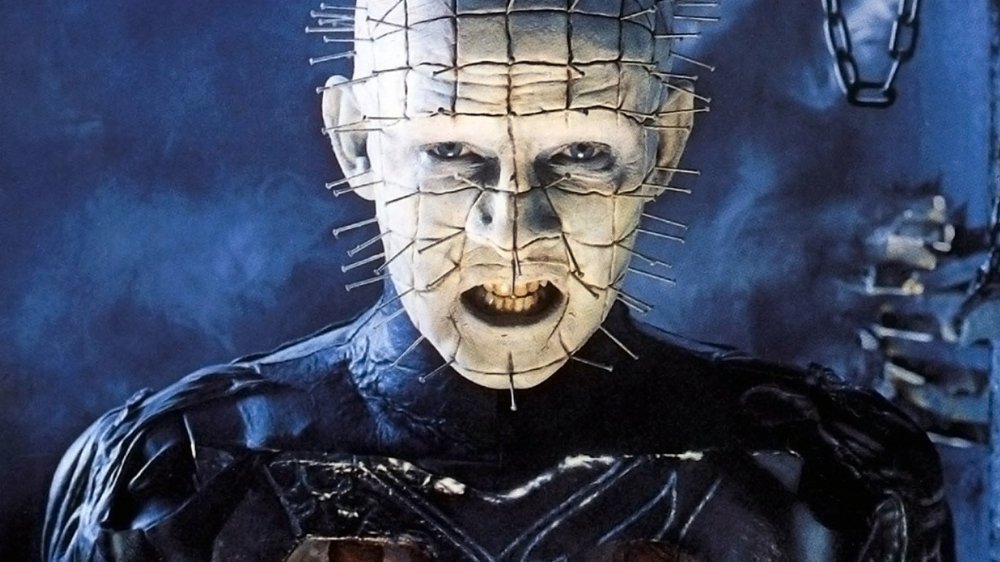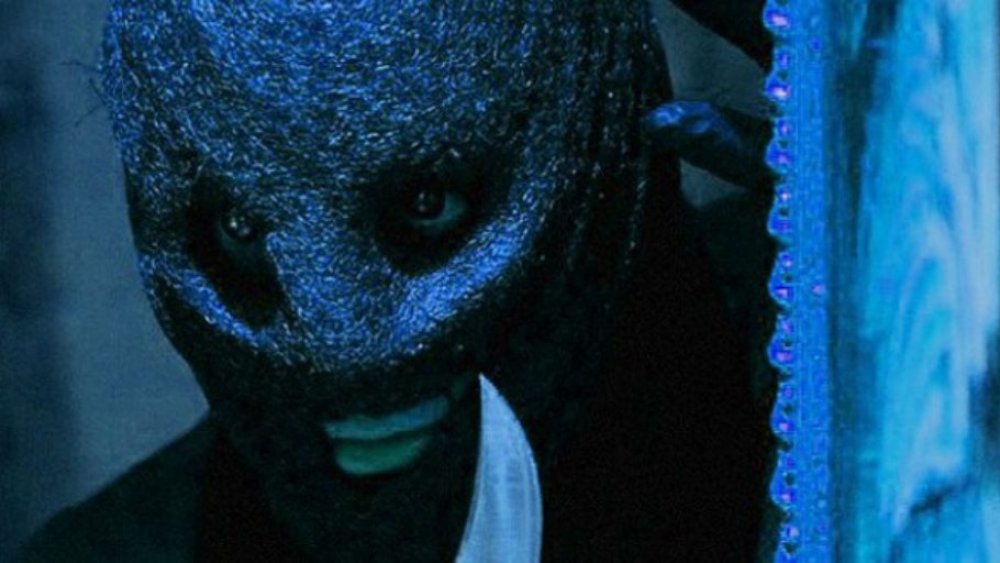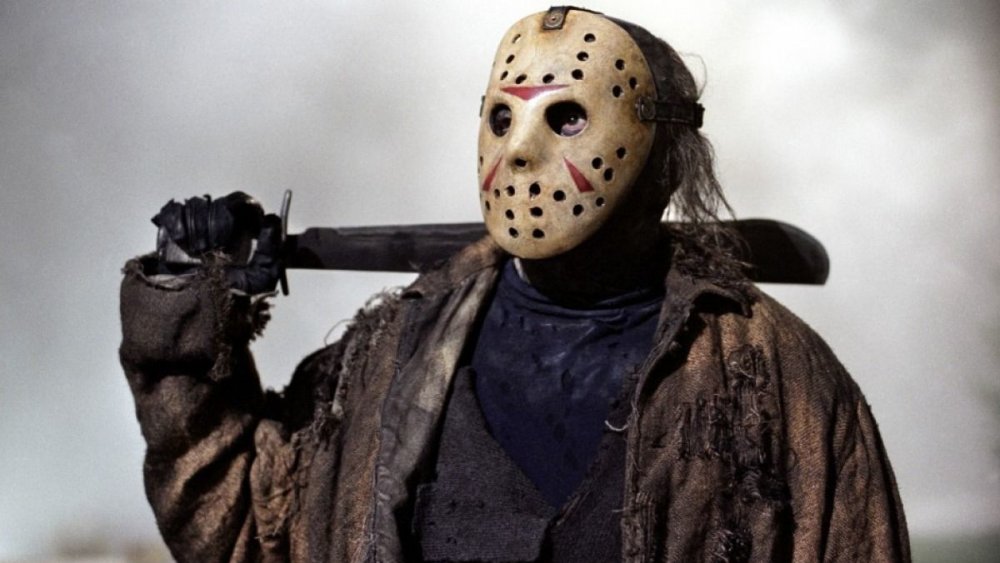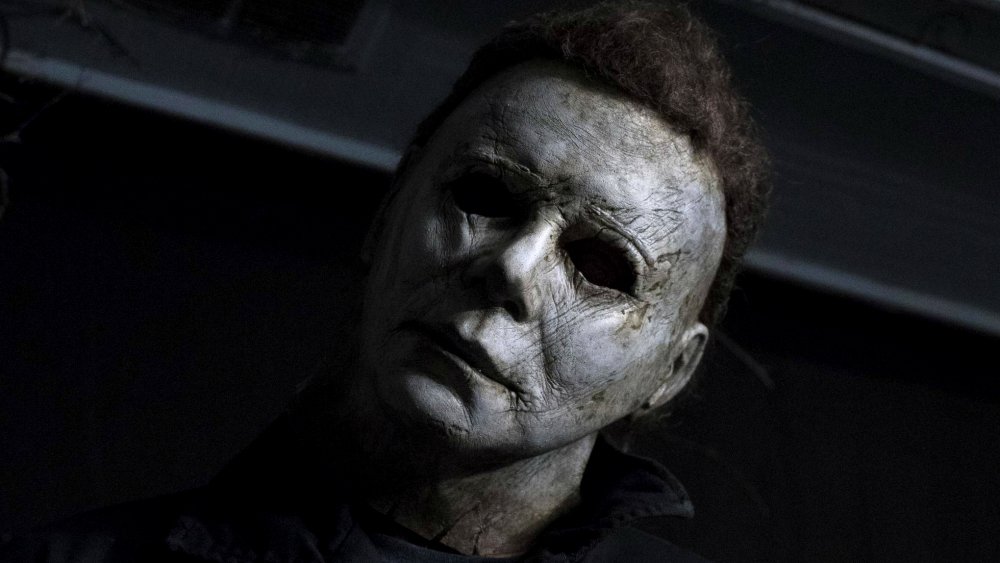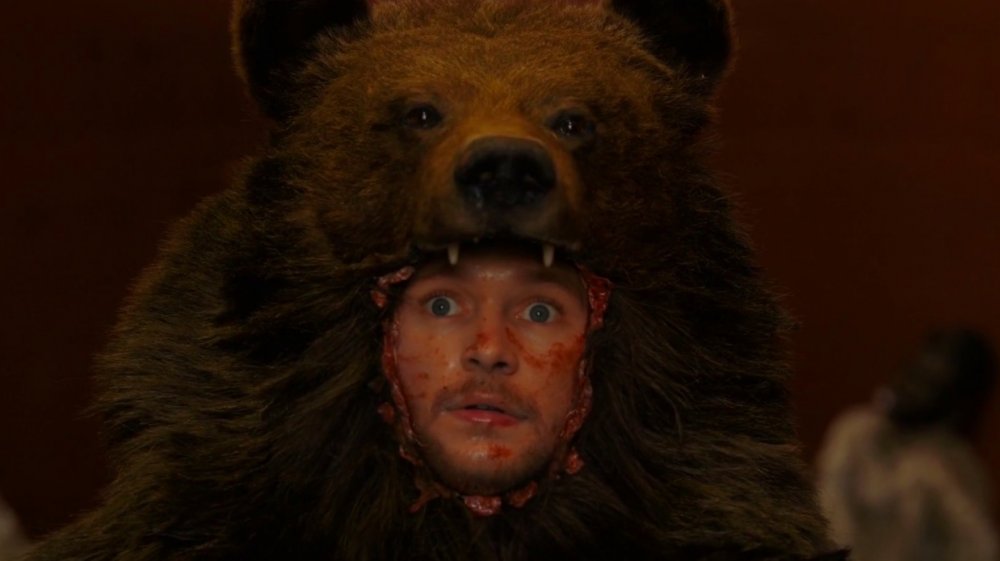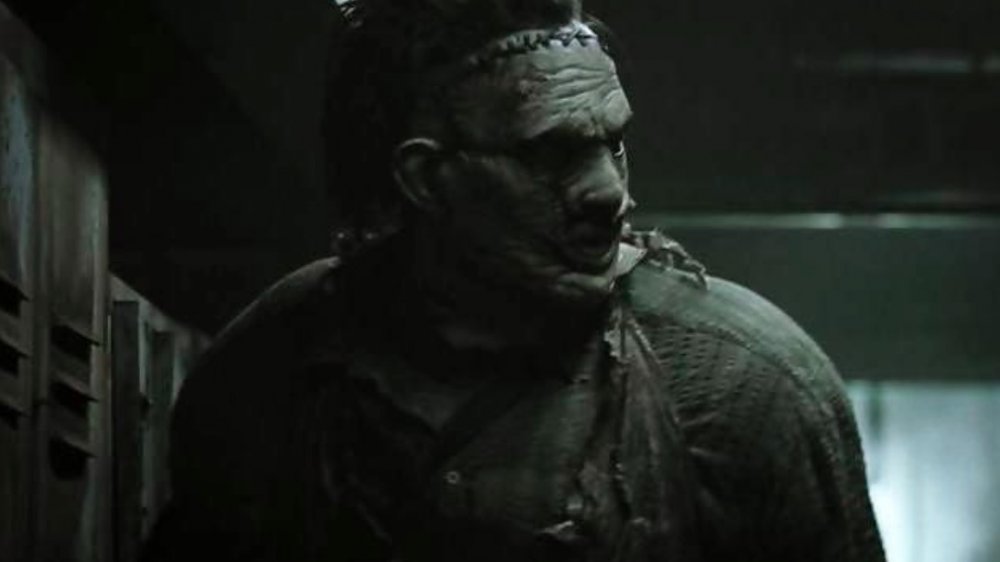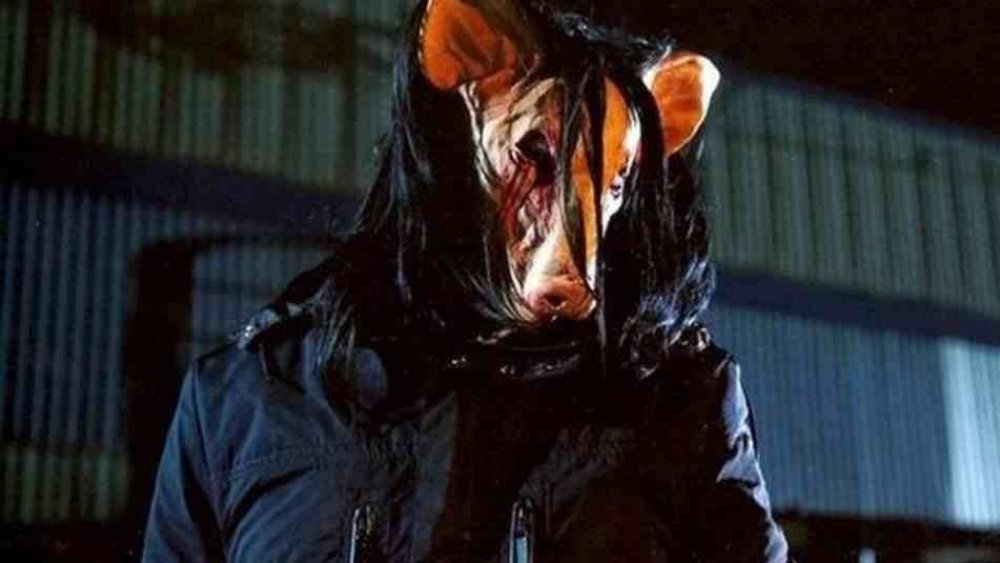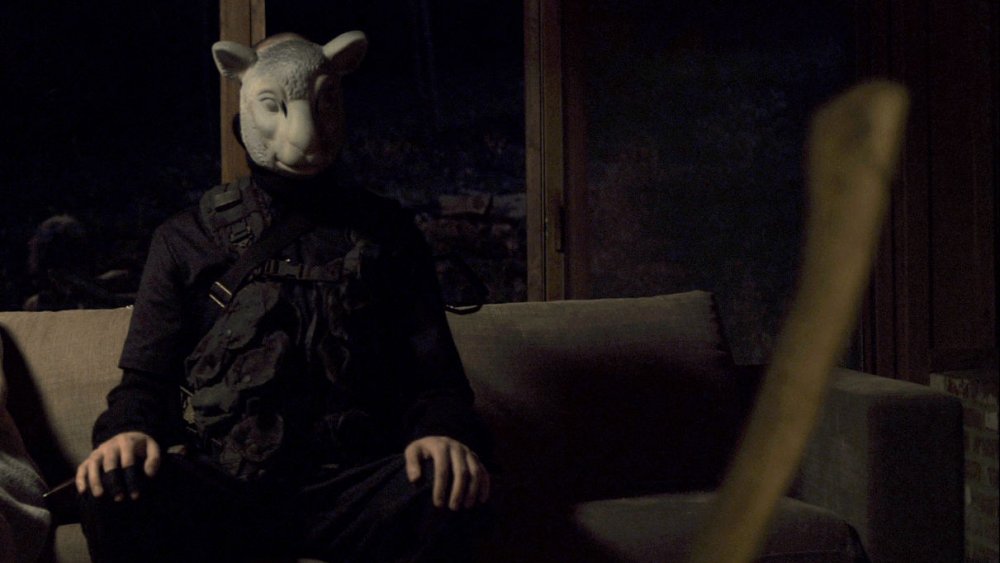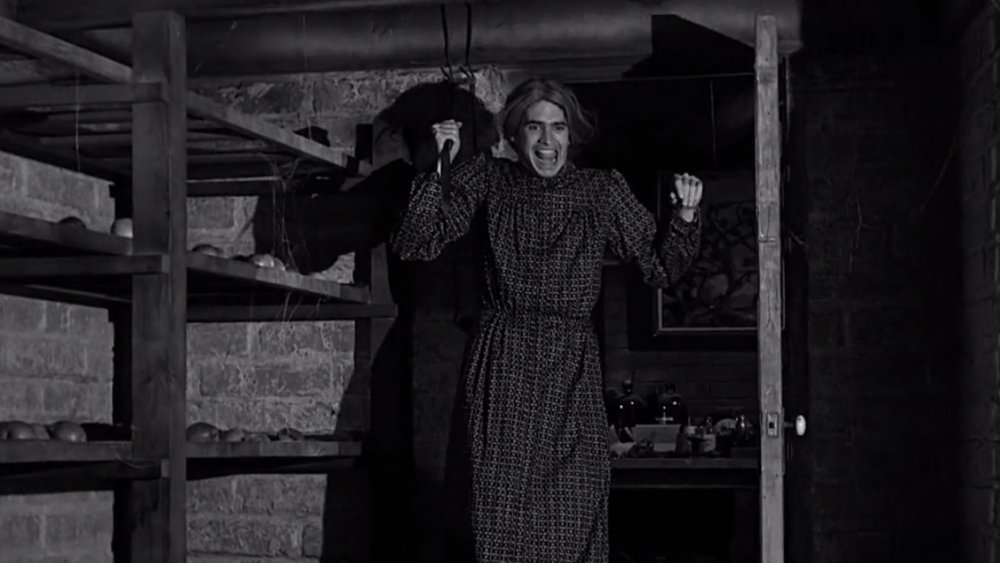The Best Horror Movie Disguises In History
Do you remember the first horror movie villain who terrified you? Maybe you saw a face, or a shadow, in the closet for weeks. Maybe you started using the nightlight you thought you'd grown out of. As time goes on, the inherent fear of death that these killers create is only enhanced by their iconography: there is often a substantial symbolic (and/or psychotic) background to the masks, costumes, and other presentations they choose.
These disguises offer a glimpse into what motivates the evildoers, not just to kill, but to hunt, manipulate, and torture. Without absolving their actions in the slightest, we are actually able to uncover and explore the trauma or pathology that made these villains what they are, through examining their presentation. The eyes are the windows to the soul ... but if you can't see the eyes, a mask, in this case, works just as well. For other villains, their disguises might be imposed by others, and still others remain total mysteries. Regardless of the reasoning, these disguises have stood the test of time, and are hard to forget, much less look away from.
Warning: Some images and topics may be disturbing.
Ghostface Killer in Scream
The infamous Ghostface mask, as well as the title of the 1996 movie, is a reference to Edvard Munch's painting popularly known as "The Scream." Munch's work of art is assumed to depict the panic and anxiety of human existence, and according to the BBC, and came to him one day when the blood-red splash of the setting sun onto the clouds gave him the sense of an unending scream passing through the world.
With that said, it would be strange if the painting didn't inspire a Halloween costume.
Wes Craven discovered the mask after it had been released as a costume product, according to the Hollywood Reporter, and found it ideal for his film, Scream. This mask also helped disguise the fact that the killer was actually two people working together to take revenge on Sidney's mother. The existentialist philosophy that "The Scream" is often associated with points toward there being no inherent meaning in life, meaning people can (and must) create their own purpose, and this plays into the villain's motivations in the film: Sidney's mother's affair tore Billy's family apart, and sucked the meaning from his life, compelling him to predicate new meaning in his life ... on his violent quest for revenge.
Mr. Tusk in Tusk
Kevin Smith's shocking film Tusk, released by A24 in 2014, isn't as well-known as some of the other entries in this list, but is quite horrific. This movie's disguise is unique in that it is a suit imposed on the victim by the killer, rather than a costume worn by the killer himself. Worse yet, the "costume," a morbid walrus suit, is constructed from the skin of the victim, Wallace, himself.
Howard Howe, an eccentric, deceptively wheelchair-bound old man who lives in the middle of nowhere, severs parts of Wallace's limbs and re-stitches his skin to form the essentially functional walrus suit, carving tusks out of his tibia bones. We know the suit is functional, because the delusional man forces the terrified Wallace the Walrus to swim.
Why a walrus? Before Howard retired as a seaman, he survived a shipwreck with the aid of a walrus who rescued him and pulled him to safety on the rocks. But he remained stranded, if alive, for so long that eventually, to keep from dying of hunger, he had to eat his savior and companion. Since then, he has attempted to recreate Mr. Tusk multiple times, hoping secretly that one of them will have the fortitude to kill him and do justice to the memory of the friend he betrayed.
Hannibal Lecter in Silence of the Lambs
Contrary to what some people might believe on their initial viewing of 1991's The Silence of the Lambs, the unforgettable mask worn by Hannibal Lecter is not a tool of silence, used to prevent the killer from speaking. It is, rather, related to his cannibalism, and a memento to the time he spent in the psychiatric hospital as a result, where the mask simply kept him from biting people. As some have pointed out, the mask's original purpose — even more than restricting his ability to bite people — served as a signal to others, to not to get too close to him. Basically, It kept others safe by managing their behavior, not his.
As a bonus, the mask itself is a little unnerving. Something about the cage that guards Hannibal's mouth is enough to set you on edge. Perhaps the unsettling quality arises from the fact that the mask looks like a perpetually open, but grimacing, mouth, with the teeth gritted in tension and neurosis, and always grinding in anticipation of the next human meal.
The iconic clown visage from It
Pennywise the Dancing Clown appears both in the 1990 miniseries It, and the two-part film series from 2017 and 2019. His clown look, of course, isn't a disguise in the same sense that a human killer dons it to mask their identity. Rather, it is a symbolic and anthropomorphic form, taken by an ethereal force of evil, specifically in order to lure people in and then prey upon their fears. The clown manifestation is one of many that this ancient entity has taken — most of the other unknown — over the centuries, during which time the evil preys upon the children of Derry, Maine, every 27 years.
Stephen King chose the form of the clown after asking himself what scared children more than anything else in the world. The fear of children was central, because one of the entity's main powers, which allows it to terrorize the youth of the town, is its ability to go undetected by adults. The killer clown's sewer habitat, meanwhile, was inspired by the troll in the "Three Billy Goats Gruff" children's story, who dwells under a bridge. In almost every way, the disguise, especially in the context of its background, represents a villain designed specifically for targeting children.
Pinhead in Hellraiser
Hellraiser, the 1987 inaugural film of its franchise, features a villain who probably did no favors for the acupuncture industry, because his face is stuck full of pins. Once a human known as Elliott Spencer, he became an extra-dimensional being who, after losing his faith in God, evolved to embrace his sadomasochistic tendencies through a little puzzle box with dark powers.
As the series itself evolves, Pinhead is portrayed as increasingly demonic. At first, his drive was simply a devotion to his appreciation for the paradoxical merits and even pleasures of pain and suffering. His facial aesthetic — his unique form of body modification, a trend that all of his fellow "Cenobites" embrace in their own ways — reflects this fixation in brutal fashion. The costume design was supposed to include evidence of an actively occurring torture, as well as indications of some sort of butchery, hence the masochistic acupuncture.
It's worth noting that Pinhead wasn't credited as such until the 1988 sequel Hellbound: Hellraiser II, after the crew of the first film pinned the well-suited nickname to the character. Creator Clive Barker, though, never liked the name, according to Dread Central.
The Collector
Originating from a script entitled The Midnight Man, the film now known as The Collector was touted as a potential Saw franchise prequel, according to horror site Bloody Disgusting. When the Saw crew shot it down, it became its own project, which was released in 2009.
The human behind the mask in The Collector is an entomologist, a scientist who studies and collects insects. He is the son of a museum curator, who essentially drove him mad and is largely responsible for both his career and his crimes. Many of the Collector's instruments of capture mimic animal and insect traps, and the act of collecting people derives directly from his scientific experience. His goal is to kill as many people in a group as possible, and then add the survivor to his collection, which recalls themes of Darwinism and the survival and cultivation of the fittest.
Viewed from behind on the movie poster, the killer tightens the laces of his leather mask. In the 2012 sequel,The Collection, the burnt and empty mask serves as a warning that the killer has escaped with his life after his victims set a fire intended to kill him. This discovery is the impetus to one of them tracking down and confronting the killer.
Jason Voorhees in Friday the 13th
Hockey is a pretty violent sport, but nowhere near the violence of serial killing. Nonetheless, the sport's traditional goaltender mask will now forever be linked with one of the greatest horror movie villains of all time, that being Jason Voorhees from the Friday the 13th franchise.
While the world first met Jason in 1980, at the end of the original Friday film, it actually took until 1982's Friday the 13th Part III before his trademark mask came into the picture — courtesy of prankster (and Jason victim) Shelly. Prior to that, Jason wore a burlap sack with one left eye hole to hide his face.
Jason would go on to wear the mask until his "death," via a bludgeoning from a kid named Tommy Jarvis. However, even after getting hacked up with a machete and buried, the legacy of Jason's mask lived on. A similar mask is worn by Roy Burns, his copycat killer. After that, Tommy himself has a nervous breakdown, and nearly becomes a copycat killer himself, donning a similar hockey mask. Following this, Tommy goes to make sure Jason is dead, throws the mask on his grave, accidentally revives the killer through lightning (long story) and Jason stumbles his way through movie after movie, as the same mask gets increasingly beaten up. As for why he likes the hockey mask in the first place? Other than being inspired to wear it by his adversaries, Jason's reasons remain unknown.
Michael Myers in Halloween
Michael Myers, the not-so-talkative villain of the Halloween series, is meant to be seen as the incarnation of pure evil ... which isn't exactly a compliment to William Shatner, whose face inspired the mask that the killer wears. Why? Basically, it came down to budget. The original Halloween didn't have a lot of money to spend, and so the killer's mask was just something bought from a local costume shop, for a meager $1.98.
This hasty solution worked great for the first movie, but created some difficulties when they decided to do a sequel. Rick Sternbach worked as an illustrator on a number of Star Trek franchise projects, as well as on Halloween 2. On the set of the latter film, as he tells it, he could only find one mask from the original film, and no one had any clue where to get more. Luckily, Sternbach discovered a serial number etched into the neck area of the mask, along with the name of the vendor, Don Post Studios. A quick phone call later, and it turned out to be their Captain Kirk mask. In exchange for credit, Don Post sent over a whole box.
It's insane how close the franchise came to having to replicate the mask, for lack of an original, or perhaps to invent a canonical excuse to change the killer's disguise altogether. Thankfully, though, the creepy mask remains an icon, even if it still doesn't look that much like Shatner.
The bear suit in Midsommar
The sacrificial garb depicted in the 2019 film Midsommar is another example of an intensely symbolic disguise that's forced upon the victim, rather than sported by the killer.
Midsommar chronicles the pagan rituals that take place at a festival celebrated by a Swedish cult once every 90 years. A group of students, many studying cultural anthropology, respond excitedly to their Swedish "friend" Pelle's invitation to the festival: Really, he is luring them there to serve as elements of the rituals, some of which will demand their deaths. One student, Dani, wins a maypole dancing competition and is crowned May Queen, a title that grants her the responsibility of choosing the final and principal sacrifice of the festival, who will be put into a disemboweled bear suit and burned alive to represent the purging of the worst qualities of the commune (via Esquire). Dani chooses her emotionally distant and unfaithful boyfriend, played by Jack Reynor.
In Norse mythology, the bear symbolizes the kind of strength and healing that bring balance to the human and spiritual world, which is what the sacrifice of Christian in the bear suit is supposed to accomplish in its sin-purifying mission. The wearing of bear (or wolf) costumes was a symbol of power in Viking culture, according to Norse Mythology for Smart People ... but Christian, in the film, is the opposite of a god and leader, so in a fascinating inversion, the bear suit serves as the vessel of his destruction.
Leatherface in Texas Chain Saw Massacre
Leatherface, introduced when the Texas Chain Saw Massacre franchise began in 1974, is a cannibal who wears a mask made from his victim's skin. It's nice that he doesn't throw away his leftovers. Maybe the victims' faces just don't taste as good, but regardless, that's more speculation than we need to entertain.
More so than almost any other killer, Leatherface's different masks — he uses a number of them, sometimes even to express different moods — expose a lot about his psyche and desires, or even, arguably, create them. This might be why the character has garnered empathy from some viewers, because he seems to simply be a large child, acting completely at the whims of his family. One way or another, his personality is externally determined, in nearly every instance. His "Killing Mask" is, of course, the one he wears to capture and kill people. But he also has a "Pretty Woman Mask," and an "Old Lady Mask," which facilitate his respective desires to honor his country upbringing by dressing up and being domestic, caring, and helpful.
The most significant aspect of Leatherface's mask habit? The masks themselves are, arguably, the only way he exhibits any sense of personality. The only thing they obscure, in fact, is emptiness.
Jigsaw from the Saw franchise
John Kramer, as the Jigsaw killer of the Saw Movies, wears a pig mask. This is first introduced in the original film, as a detail that one victim, Adam, recalls. Later in the series, the mask is revealed to be a tribute to the Year of the Pig, in which Jigsaw began his work. In Chinese zodiac legend, as well as pop culture, the pig can symbolize laziness, the antithesis of the "will to live" that John attempts to divine in each of his test subjects. The pig is also the final animal of the zodiac cycle, which can be read as a symbol of John's cancer diagnosis, and his serial killing being the final chapter of his life.
A pig mask containing a chloroform rag was the first tool John ever used to subdue a test subject, and he chose it personally as a representation of his pessimistic worldview and the slow decay of his body from cancer. The pig also, however, represents rebirth: Rebirth does require a death, so while it appears paradoxical at first, it actually makes sense to read the pig as a symbol both of beginning and ending. This squares up with Jigsaw's motivation and tactics, as despite the frequent deaths of his subjects, at his hands, he does want to give them a second chance at life.
The animal masks in You're Next
The cast of the killer team in 2011's You're Next are credited with the first names of the characters they play, and the name of the animal mask they wear. The team includes a lamb, a tiger, and a fox. Ironically, in the wild, tigers are known to eat foxes, and foxes to prey upon lambs. Behind the masks, though, Lamb Mask and Tiger Mask are brothers, and represent just about the only instance of familial loyalty in the film: Two of the children, Felix and Crispian, turn out to be in on the plot to massacre their own family, in order to collect an inheritance. Animal masks are the perfect representation of a home invasion, in which some wild and destructive force from outside threatens the balance within the walls of home. One inclusion you might expect, in the invasive animal cohort, is the face of a wolf, which is nowhere to be seen ... unless you mistake the fox for its lupine relative.
But perhaps we do see a wolf after all: Erin, Crispian's girlfriend, has her own primal roots, having grown up on a survivalist compound. This is something none of the conspirators anticipate, and she takes them all down one by one, surviving on her own strength as (wait for it) a lone wolf.
Norman Bates in Psycho
No, Norman Bates doesn't wear a mask. Instead, he dresses up as his mother, which is about as creepy as it gets.
Both Bates and Leatherface, among other fictional killers, are suspected to have been based loosely around real serial killer Ed Gein, also known as the "Plainfield butcher." Gein recounted having dissociative episodes when he engaged in body-snatching from local graveyards, which echoes Norman's struggle with dissociative identity disorder. Gein also dug up the bodies of two women because they looked like his mother, after whose death he set out to make a "woman suit" so that he could become his mother by literally crawling into her skin.
In that context, at least Norman stopped at the point of wearing his mother's clothes. His psychology, though, is quite similar to Gein's, as all of Norman's killings revolve around his mother. Norman's first victims are actually his mother and her lover, whom he kills out of jealousy before staging the scene to look like a murder-suicide. After this trauma, he develops dissociative identity disorder, taking on his mother's personality at times, to escape his guilt, and to kill anyone he thinks she would want dead if she were alive. This also absolves him of guilt for any other murders, in his mind. Ultimately, the sartorial and psychological disguise is a coping mechanism, in response to the loss of the most important person in his life.
